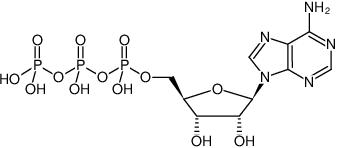100 mM Sodium salt solution
Adenosine 5'-triphosphate, Sodium salt
| Cat. No. | Amount | Price (EUR) | Buy / Note |
|---|---|---|---|
| NU-1010 | 1 ml (100 mM) | 49,90 | Add to Basket/Quote Add to Notepad |

For general laboratory use.
Shipping: shipped on gel packs
Storage Conditions: store at -20 °C
Short term exposure (up to 1 week cumulative) to ambient temperature possible. If stored as recommended, Jena Bioscience guarantees optimal performance of this product for 12 months after date of delivery.
Shelf Life: 12 months
Molecular Formula: C10H16N5O13P3 (free acid)
Molecular Weight: 507.18 g/mol (free acid)
CAS#: 987-65-5
Purity: ≥ 99 % (HPLC)
Form: clear aqueous solution
Concentration: 100 mM ±2 %
pH: 8.0 ±0.2 (22 °C)
Spectroscopic Properties: λmax 259 nm, ε 15.1 L mmol-1 cm-1 (Tris-HCl pH 7.0)
Applications:
ATP-sensitive calcium channels[1]
V-ATPases (cellular proton pumps)[2]
ATP-coupled chromatin remodelling[3]
ATP-binding cassette transporters[4]
ATP-grasp enzymes[5]
Agonistic ligand, mainly for nucleoside receptor A1
Nucleoside-triphosphates can be converted by different membrane-bound phosphatases into nucleosides acting as nucleoside receptor ligands.
Description:
Ultrapure ATP supplied as clear aqueous solution.
Specific Ligands:
Ligand for purinergic receptors:
P2X1-P2X3[6,7]
P2X1/4[8]
P2X4[7]
P2X7[9,10,11]
P2X1 - P2X7[12]
P2Y1[10,14]
P2Y2[13,14]
P2Y11[14]
BIOZ Product Citations:
Selected References:
[1] Wang et al. (2011) The biological effect of endogenous sulfur dioxide in the cardiovascular system. Eur. J. Pharmacol. 670 (1):1.
[2] Scott et al. (2011) Duelling functions of the V-ATPase. EMBO J. 30 (20):4113.
[3] Erdel et al. (2011) Chromatin remodelling in mammalian cells by ISWI-type complexes--where, when and why? FEBS J. 278 (19):3608.
[4] Gatti et al. (2011) Novel insights into targeting ATP-binding cassette transporters for antitumor therapy. Curr. Med. Chem. 18 (27):4237.
[5] Fawaz et al. (2011) The ATP-grasp enzymes. Bioorg. Chem. 39 (5):185.
[6] Lambertucci et al. (2015) Medicinal chemistry of P2X receptors: Agonists and orthosteic antagonists. Curr. Med. Chem. 22 (7):915.
[7] Ralevic (2015) P2X receptors in the cardiovascular system and their potential as therapeutic targets in disease. Curr. Med. Chem. 22 (7):851.
[8] Harhun et al. (2014) ATP-evoked sustained vasoconstrictions mediated by heteromeric P2X1/4 receptors in cerebral arteries. Stroke 45 (8):2444.
[9] Facci et al. (2014) Toll-like receptors 2, -3 and -4 prime microglia but not astrocytes across central nervous system regions for ATP-dependent interleukin-1β release. Sci. Rep. 4:6824.
[10] Stolz et al. (2015) Homodimeric anoctamin-1, but not homodimeric anoctamin-6, is activated by calcium increases mediated by the P2Y1 and P2X7 receptors. Pflugers Archiv DOI:10.1007/s00424-015-1687-3.
[11] Lord et al. (2014) Pharmacology of a novel central nervous system-penetrant P2X7 antagonist JNJ-42253432. J. Pharmacol. Exp. Ther. 351 (3):628.
[12] Dal Ben et al. (2015) Purinergic P2X receptors: Structural models and analysis of ligand-target interaction. Eur. J. Med. Chem. 89:561.
[13] Xie et al. (2014) The P2Y2 nucleotide receptor mediates the proliferation and migration of human hepatocellular carcinoma cells induced by ATP. J. Biol. Chem. 289 (27):19137.
[14] Kim et al. (2002) Methanocarba modification of uracil and adenine nucleotides: High potency of northern ring conformation at P2Y1, P2Y2, P2Y4 and P2Y11 but not P2Y6 receptors. J. Med. Chem. 45:208.
Volonte et al. (2009) Membrane components and purinergic signalling: the purinome, a complex interplay among ligands, degrading enzymes, receptors and transporters. FEBS J. 276:318.
Yegutkin (2008) Nucleotide and nucleoside converting enzymes: Important modulators of purinergic signalling cascade. Biochim. Biophys. Acta 1783:673.
Hasko et al. (2007) Shaping of monocyte and macrophage function by adenosine receptors. Pharmacol.& Therapeutics 113:264.
Holland et al. (1991) Detection of specific polymerase chain reaction product by utilizing the 5'----3' exonuclease activity of Thermus aquaticus DNA polymerase. Proc. Natl. Acad. Sci. USA 88 (16):7276.
Erlich et al. (1988) Primer-directed enzymatic amplification of DNA with a thermostable DNA polymerase. Science 29 (239):487.
Williams et al. (1986) Effects of purine nucleotides on the binding of [3H]cyclopentyladenosine to adenosine A1-receptors in rat brain membranes. J. Neurochem. 47 (1):88.
Sanger et al. (1977) DNA sequencing with chain-terminating inhibitors. Proc. Natl. Acad. Sci. USA 74:5463.